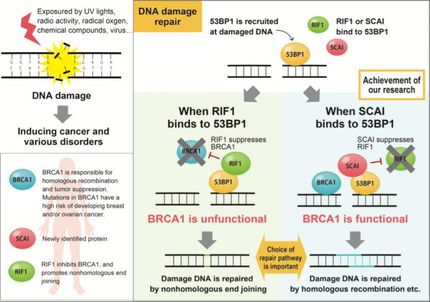The proteins ensuring genome protection
Researchers from the University of Geneva, Switzerland, discover how enzymatic onslaughts at the ends of our chromosomes are countered
Advertisement
Researchers from the University of Geneva (UNIGE), Switzerland, have discovered the crucial role of two proteins in developing a cell 'anti-enzyme shield'. This protection system, which operates at the level of molecular 'caps' named telomeres, prevents cells from treating chromosome ends like accidental DNA breaks and 'repairing' them. Joining chromosome ends would, indeed, lead to tumor formation. This study, carried out by Cyril Ribeyre and led by David Shore, professor of molecular biology, is published in Nature Structural & Molecular Biology.
Each of our cells contains two huge DNA strands, segmented into parts that are packaged within chromosomes. Each chromosome end, however, becomes vulnerable to specific enzymes that target accidental DNA breaks in need of repair. The cell is, indeed, equipped with a sensitive surveillance system that recognizes and corrects abnormalities occurring within our genome. This system includes patrolling proteins, molecules that set off an alarm, as well as damage-repairing enzymes.
In order to escape the cellular mechanisms that detect and repair damaged DNA, the ends of our chromosomes are covered by molecular 'caps' called telomeres. These complexes, formed of proteins and repetitive DNA, constitute an 'anti-enzyme shield' that protects chromosome ends. Inadvertent end joining would indeed lead to chromosome breakage and rearrangement during cell division, processes that are known to drive tumor formation.
Restraining the zeal of repair enzymes
Cyril Ribeyre and David Shore, from the Department of Molecular biology of the UNIGE, have discovered that Rif1 and Rif2, two related proteins that bind telomeres, deactivate the alarm of the DNA repair surveillance system. 'Telomeres interact with many molecules. We had identified several biochemical players, but we didn't know how they functioned', says Professor Shore, member of the National Center of Competence in Research Frontiers in Genetics. 'We have now established that Rif1 and Rif2 prevent the binding of specific proteins involved in setting off this alarm, which inhibits an enzymatic cascade at an early stage in the process'.
This local 'anti-enzyme shield' seems to extend to neighboring regions. 'Telomeres of adjacent chromosomes probably benefit from this protective system, in case they undergo severe damage', suggests Professor Shore.
These two related molecules had already been analyzed and part of their functions uncovered by the researcher's team. 'We knew that Rif1 and Rif2 were involved in regulating telomere length, which determines the life span of the cell. Both of them were also suspected to take part in the telomeric cap formation', details Cyril Ribeyre.
The multiple activities of Rif1 and Rif2 thus contribute to ensure the optimal functioning of telomeres with respect to their roles –all essential- within the cell.























































